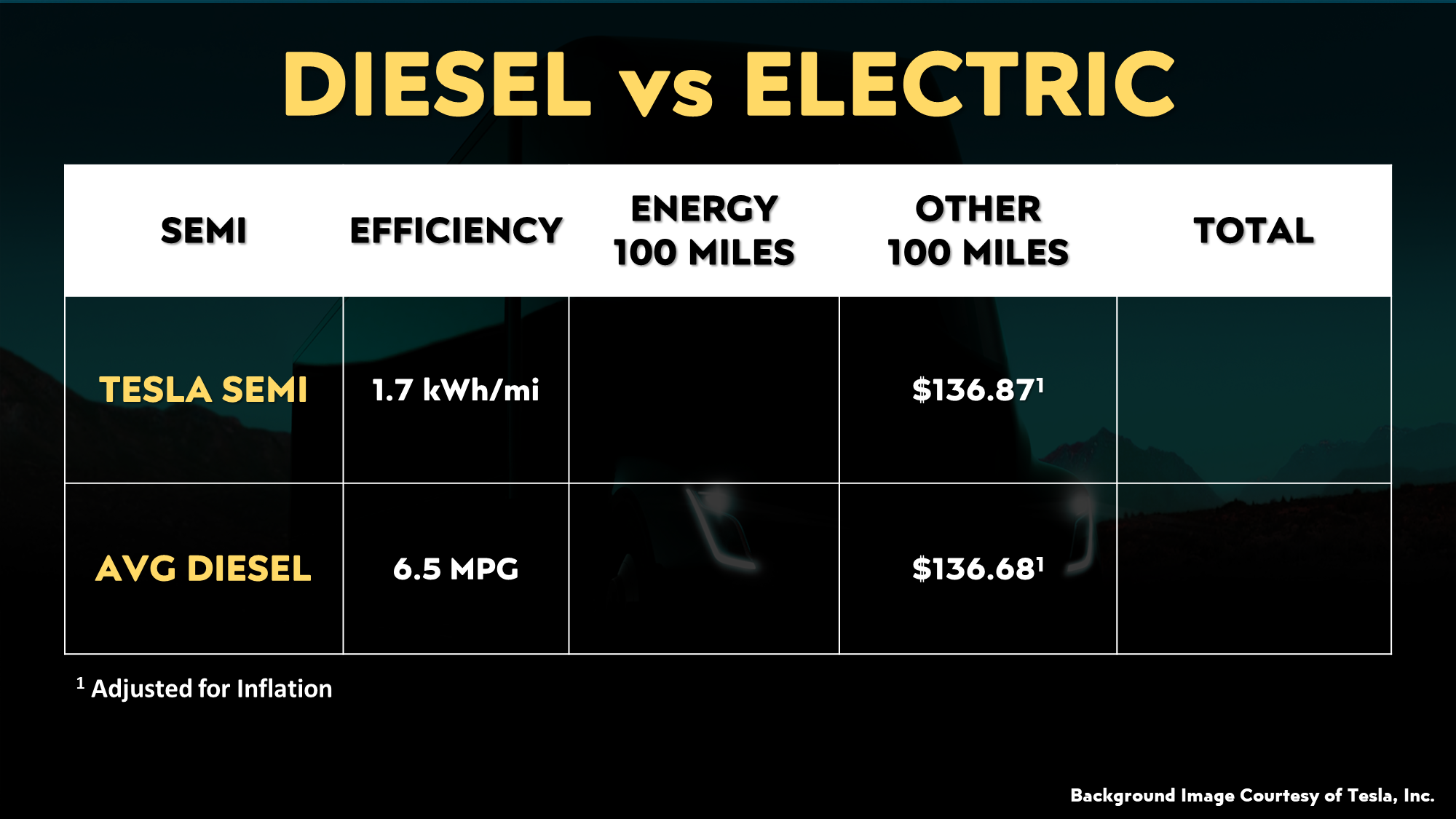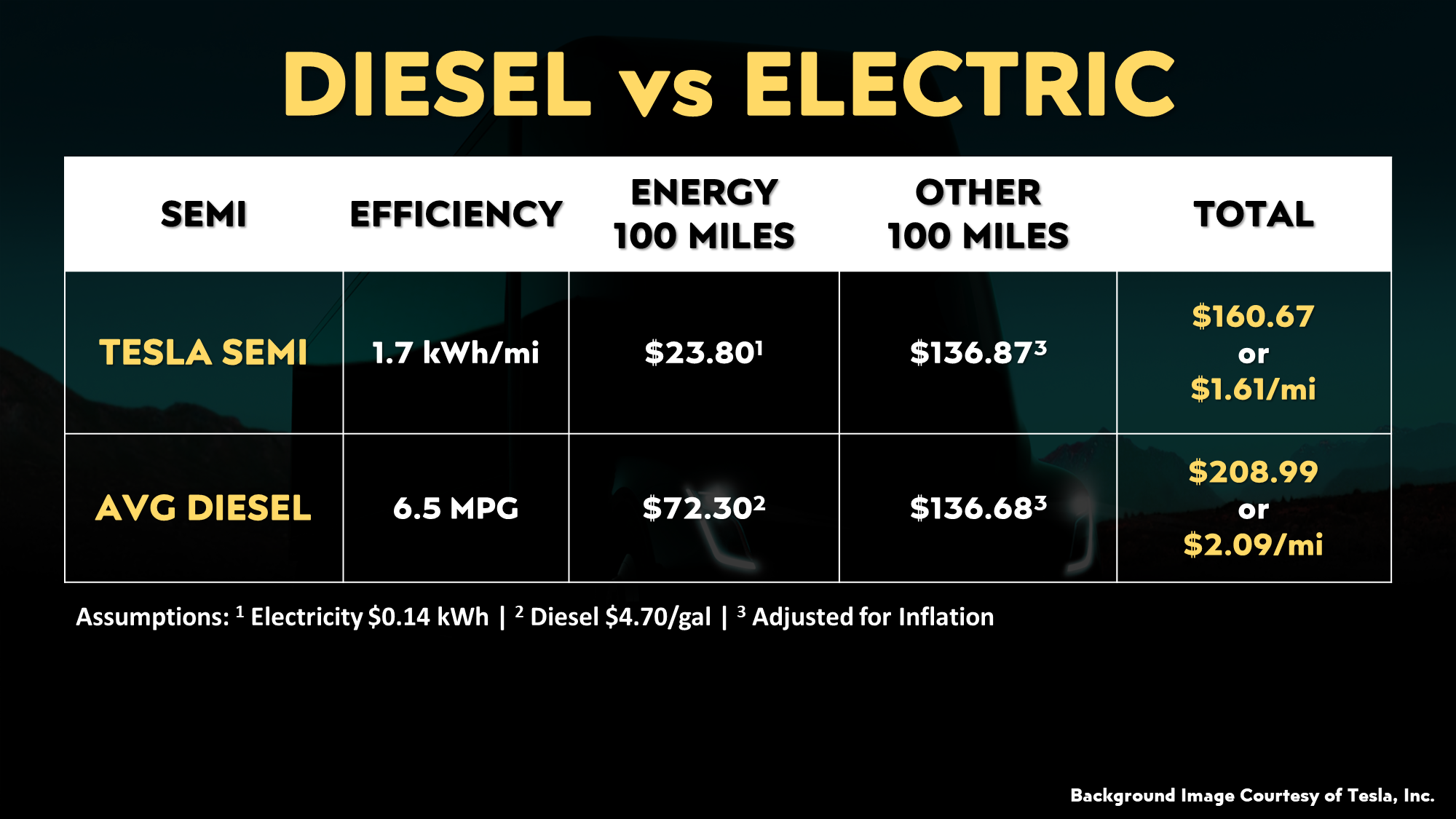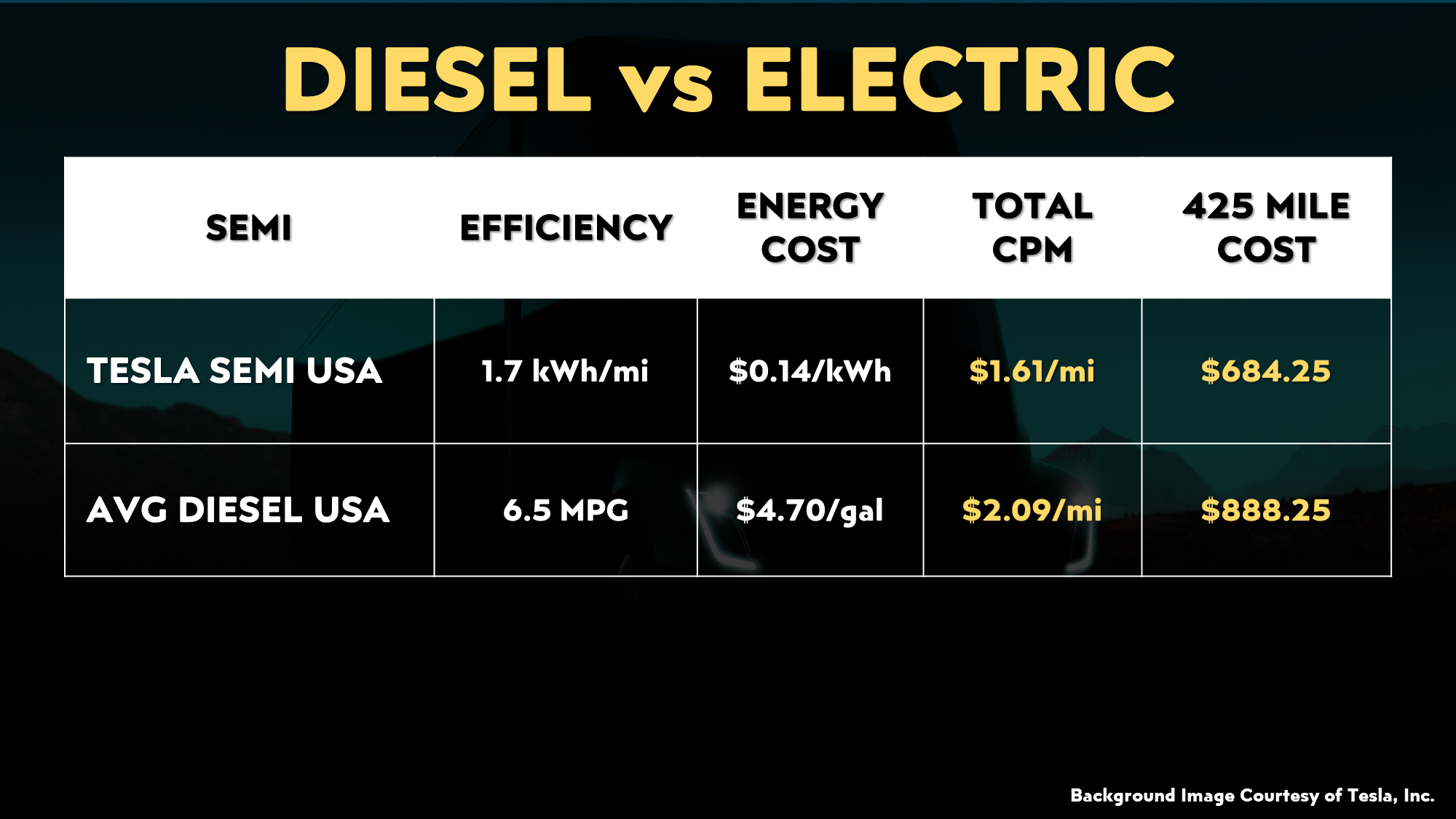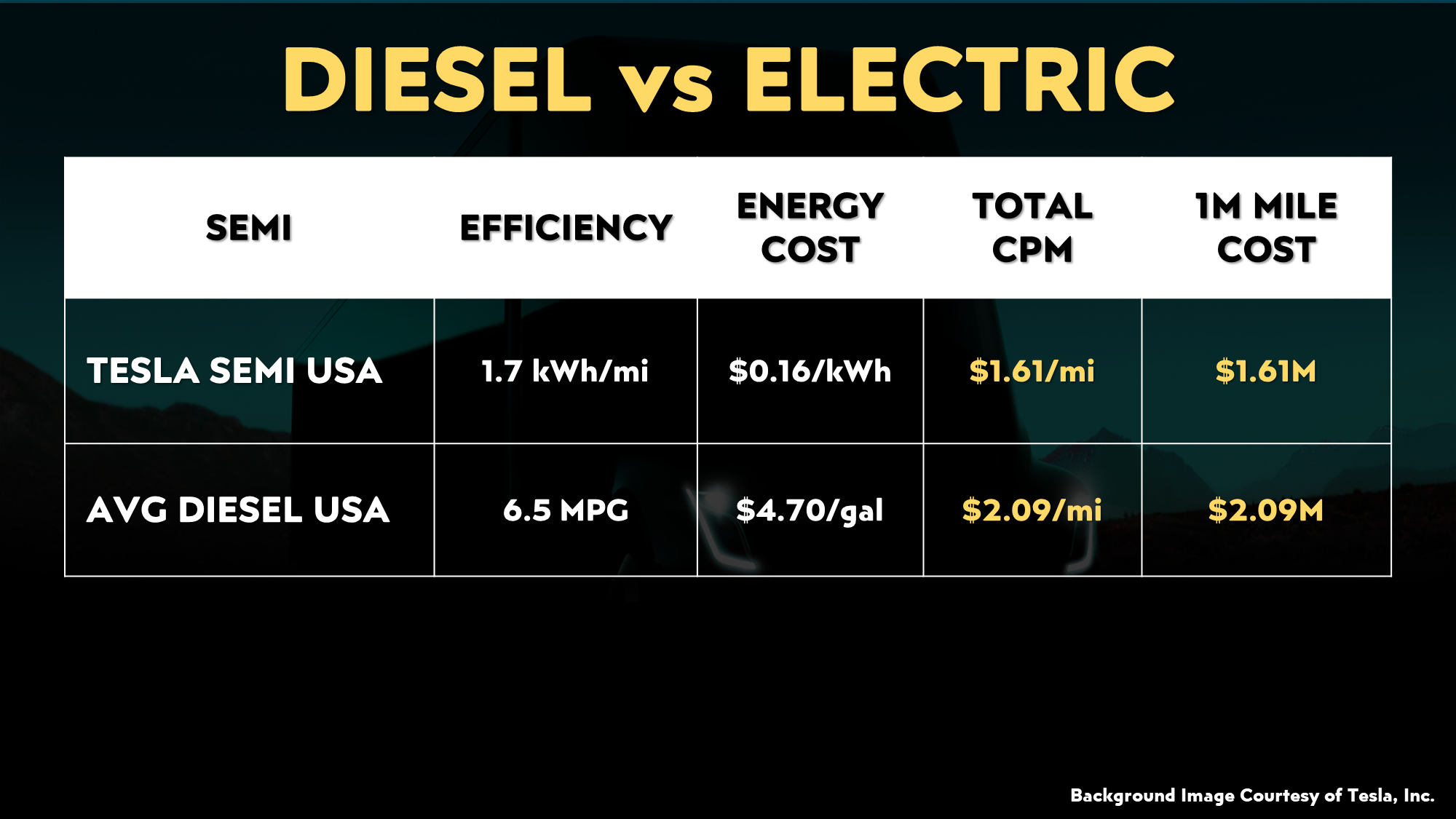The Tesla Semi Saves $BILLIONS vs Diesel Semi
PepsiCo recently took delivery of the first production Tesla semis on December 1st, and according to Reuters, PepsiCo plans to have around 100 Teslas semis in their fleet in 2023. As PepsiCo adds more Tesla semis to their fleet, it has the potential to save PepsiCo billions of dollars over time, and that’s no exaggeration. Due to the potential cost savings of replacing a diesel truck with a Tesla semi, I believe that demand for the Tesla semi will far outpace supply for some time.
Environmental Benefits Alone Are Not Enough
While the Tesla semi has very obvious environmental benefits, the truth is, environmental benefits alone are not enough for many companies to replace their diesel fleets with Tesla semi trucks or other electric semi trucks. There must also be a financial incentive to make the switch, and this is definitely the case with the Tesla semi. Some of you might be wondering right now, how in the world am I going to be able to accurately calculate the operating cost of the Tesla semi with a limited set of data? Well, thankfully when Tesla unveiled the semi back in 2017, they did share an operating cost comparison of the Tesla semi versus a traditional diesel semi. While a lot has changed since 2017, and costs have risen since then, I believe this is still a good model that we can use as a basis for our new calculations and to bring them up to date to the present time. In the end, these calculations should be relatively close to the actual operating cost of the Tesla semi.
What Tesla Shared in 2017
In 2017, Tesla estimated that for a 100 mile route, fully loaded with 80k lbs. GVW, a typical diesel truck would cost approximately $1.51 per mile to operate as compared to the Tesla semi, which they estimated should cost around $1.26 per mile. This represents a $0.25 per mile difference which may not seem like a lot, but since a typical semi will travel somewhere around a million miles in its lifetime, saving $0.25 a mile, actually becomes a significant cost savings with time.
However, this data is a bit out of date, because Tesla calculated these operating costs with diesel at $2.50 per gallon and electricity at $0.07 per kilowatt hour. I don't know if Tesla still plans to have guaranteed electricity rates for the Mega Charger network like was mentioned at the Tesla semi reveal event, but nonetheless, PepsiCo is currently charging the Tesla Semi at their own facility - not at Mega Chargers. So, they are most likely paying much higher electricity rates at each of their facilities and not $0.07 per kilowatt hour as they charge the Tesla semi. However, before we update these numbers, we need to find out how much of this operating cost accounts for the cost of fuel/energy, and how much of it includes other associated costs like depreciation, maintenance and repairs.
Breaking Down the Costs
According to my research, a typical diesel semi averages around 6.5 miles per gallon. So, for a 100 mile trip with that kind of efficiency, you would use a little bit over 15 gallons of diesel. If you multiply that by the cost that Tesla listed use in their calculations [$2.50/gallon], that would mean, that roughly $0.38 per mile accounts for fuel costs, which is around 25% of the total cost per mile of $1.51. So, we can estimate that for Tesla's calculations, somewhere around 25% of the diesel semi cost was for fuel, and 75% of this cost included other categories.
(100 miles / 6.5 mpg) x $2.50 gallon = $38.46
$38.46 / 100 = $0.3846 per mile for fuel cost
$0.3846 / $1.51 = 0.2547 or 25.47%
Diesel Semi: ~25% of CPM is fuel & ~75% is other
If you do that same calculation for the Tesla semi using the 1.7 kWh per mile efficiency that Elon revealed on Twitter and using the $0.07 per kWh electricity cost that Tesla provided for their calculations, you can see that energy costs made up just a bit under 10% of the total operating costs for this 100 mile trip. So, roughly 10% of the operating cost per mile for the Tesla semi that Tesla provided was for energy cost, and 90% of it was for other, which once again likely includes things like depreciation of the vehicle, maintenance and repairs. .
(100 miles x 1.7 kWh/mile) x $0.07 kWh = $11.90
$11.90 / 100 = $0.119 per mile for energy cost
$0.119 / $1.26 = 0.0944 or 9.44%
Tesla Semi: ~10% of CPM is energy & ~90% is other
So, using these estimated percentages for a diesel semi, 75% of $1.51 equals and other cost of just a bit over $1.13, and for the Tesla semi, 90% of $1.26 also equals also just a bit over $1.13. In order to stick with that 100 mile trip that Tesla used in their calculations, we can simply multiply this number by 100 to get the cost for a 100 mile trip. It is interesting to note that the cost per mile excluding energy costs is pretty much the same between the Tesla semi and the diesel semi, with only a small difference between the two.
Diesel Semi: ~75% of CPM is other
75% of $1.51 = $1.1325 cost per mile
100 mile Cost: $113.25
Tesla Semi: ~90% of CPM is other
90% of $1.26 = $1.134 cost per mile
100 mile Cost: $113.40
We Need to Adjust for Inflation
As was mentioned previously, the cost of doing business has risen substantially since 2017, so to bring these numbers up to date, we need to adjust these amounts for inflation. The United States Department of Labor website has a handy inflation calculator that I used to update these numbers which increases this cost to nearly $137 from the roughly $113 figures we came up with earlier.
Now, when it comes to the energy cost calculation, I think it's important that we do two different calculations here. One accounting for California energy costs, and a second for the U.S. average cost. The reason I'm starting with California first, is because according to Reuters, “PepsiCo said it plans to deploy 15 trucks from Modesto and 21 from Sacramento.”
California Energy Costs
According to the Energy Sage website, the average electricity rate in California is just a bit under $0.29 per kilowatt hour, and according to AAA’s website, the cost of diesel in California is just a bit over $5.60 a gallon. So assuming $0.29 per kilowatt hour for electricity and $5.60 per gallon of diesel, I estimate that the Tesla semi in California would cost around $1.86 per mile, and a diesel semi would cost around $2.23 per mile. That represents roughly a $0.37 difference, meaning that operating cost of the Tesla semi is about $0.37 per mile cheaper in California than a typical diesel semi.
USA Average Cost Per Mile
Moving to the operating cost for the broader USA market, According to AAA, the average cost of a gallon of diesel is somewhere a bit under $4.70 a gallon and according to the Save on Energy website, the average electric price for a business customer in the United States for electricity is $0.1345/kWh. So, if we assume $0.14 for kilowatt hour and $4.70 per gallon of diesel, our cost per mile comparison does change a bit and it appears like the Tesla semi could save their operators around $0.48 per mile as compared to a diesel semi.
What about Replacing the Battery?
Before I show how PepsiCo and other companies can potentially save billions of dollars by adding the Tesla semi to their fleets, I want to address the potential issue of needing to replace the Tesla semi battery pack before the truck’s end of life. How would that effect the cost savings that we have been discussing? In response to that question, I believe that Tesla has actually built in the cost of replacing the battery pack into their operating cost estimates, and here’s why. Notice that when I calculated the cost per mile for the Tesla Semi excluding the cost of energy, we were left with an other cost that is nearly identical. Logic would suggest that an electric semi truck should need quite a bit less maintenance, which should make the other category lower for the Tesla semi, unless Tesla including the cost of replacing a battery pack in their calculations. Now I do understand that the Tesla semi cost a bit more than the average diesel semi, and maybe part of this cost is the depreciation cost difference, however, I don't believe that's actually going to make up much of a difference.
For example, a typical semi is expected to last somewhere around a million miles before its end of life, and even though the Tesla Semi does cost more than a diesel semi, back in 2017, the cost difference was probably calculated to be somewhere around $50,000. So, a $50,000 difference divided by a million miles is only a $0.05 per mile added costs. I don’t think that's enough to make these numbers make sense. It makes more sense that Tesla has accounted for replacing the battery pack during the truck’s million mile lifetime, say for example after 500,000 miles, and this could help make these calculations make a lot more sense. I could be wrong, but I believe that this makes the most sense.
How the Tesla Semi should Save PepsiCo Billions
As I mentioned earlier, according to Reuters, PepsiCo plans to have 100 Tesla semis in their fleet in 2023, and for their Frito-Lay division, they plan to use the Tesla Semi for a 425 mile route. So, once again, going with the cost per mile calculations that we came up with earlier, the Tesla Semi should save PepsiCo a bit over $200 for each 425 mile trip over a typical diesel semi.
But, of course that's just one small trip so, I think it's important that we look at the much bigger picture for the entire lifetime of the Tesla Semi and the long term savings that could be recognized. According to Reuters, PepsiCo normally plans to drive their trucks for seven years, or a million miles. So on a bigger scale, if you do that cost per mile for a 1 million mile lifetime cost, you can see that the Tesla semi in its lifetime could very well save PepsiCo around $480,000, according to my estimates.
The More PepsiCo Buys, the More they Save
While I believe that these costs per mile calculations are based on model [from Tesla] which included the cost of vehicle depreciation into the equation, to be safe, I'm going to go ahead and discount this savings amount based on what I believe the Tesla semi costs more than diesel truck. I don't believe this is even necessary, but I want to make sure that these calculations are not too overly optimistic. Back in 2017, the non-founders version of the 500 mile range Tesla semi was supposed to cost around $180,000, however, due to rising material cost, I believe the Tesla semi probably costs more like $250,000 in today's money. So, let's just assume for a minute that the Tesla semi does indeed cost $250,000 and that's what Pepsi paid for their Tesla semis and will pay in 2023. If a typical diesel semi costs somewhere around $150,000, that means there's roughly $100,000 cost difference there between the two, meaning the Tesla semi could potentially cost $100,000 more than a typical diesel semi. So, if you start with a $480,000 lifetime savings difference and subtract that $100,000 cost difference, that gives you a savings of $380,000 for the lifetime of the Tesla semi truck.
$40,000 Federal Tax Credit
The savings actually get better, because the United States is offering a huge incentive starting in 2023 of up to $40,000 per electric heavy duty truck that companies purchase. So, in reality the savings could very well be greater than $400,000 per Tesla Semi added to their fleet as compared to a typical diesel semi. This is not even including a $15.4 million state grant that Pepsi also received from the state of California.
So when it comes to how this looks, saving roughly $400,000 for each Tesla semi that replaces a diesel truck, 100 Tesla semis has the potential to save PepsiCo around $40 million in their lifetime, 500 Tesla semis could save them somewhere around $200 million in their lifetime and 1,000 Tesla semis could save them somewhere around $400 million in its lifetime. If PepsiCo adds 10,000 Tesla semis to their fleet, that could save them somewhere around $4 billion. Of course, $4 billion is a lot of money, and if you can save $4 billion, why wouldn't you switch to the Tesla semi? Because of this, I believe PepsiCo will end up ordering quite a few more than just the 100 semis and I expect PepsiCo’s Tesla semi fleet to be quite large in the future.
Size of PepsiCo Fleet
For refence, PepsiCo has a very large fleet. According to the Federal Motor Carrier Safety Administration website, the Frito-Lay division of PepsiCo has a fleet of over 15,000 vehicles. So, I think in the future, PepsiCo having somewhere close to 10,000 Tesla semi in their fleet doesn't sound crazy. And Tesla does plan to mass produce the Tesla semi because once again, going back to their Q3 2022 conference call Elon Musk mentioned aiming for 50,000 units in 2024.
Solar Power Can Make the Savings even Greater
Of course $4 billion of savings, is huge by itself, but the savings could be even greater with the addition of solar and wind to installed at PepsiCo’s facilities. According to a design news article from back in 2010, the Frito-Lay facility in Modesto had a one megawatt solar installation, which represented somewhere around 25% of their electricity use. Moving forward here to the end of 2022, PepsiCo actually has an emphasis on installing solar and renewable energy sources on their facilities because on their corporate website, they mention,
“Progress towards our goal is being achieved in part by building new wind and solar installations at our plants and distribution centers, coordinated by local and sector teams.”
As PepsiCo adds more and more solar to their facilities, this has the potential to save them even more and eventually they could be powering the Tesla semi on solar power alone! As PepsiCo starts realizing these savings in real life situations, I believe other companies also are going to take notice and I fully expect that Tesla will be able to sell every semi that they can build for quite some time. Tesla clearly has the best electric class 8 truck on the market right now, and when you add in the cost savings, it makes switching to the Tesla semi a no brainer.












